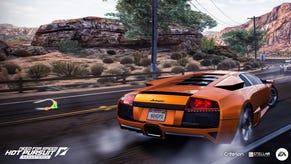Hot Pursuit PS3/360 demo showdown
Pixel perfect.
Yesterday's release of Criterion's Need for Speed: Hot Pursuit demo serves to remind us that when it comes to cross-platform development, the Guildford-based studio is in a class of its own. Everything about the demo suggests that the PlayStation 3 and Xbox 360 versions of the new racer are almost totally identical.
In our Face-Off features we often talk about the social gaming network you have being more important than often minor technical differences, and Hot Pursuit is probably the most dramatic example of how important your friends list is in terms of which version of the game you should purchase.
The more people you're connected to playing the game, the better it gets. The demo craftily introduces you to this by locking out one of the two events, only making it available when someone else on your friends list has downloaded and played the sampler. With times logged, the competition begins in earnest and the ingenuity of Autolog system begins to manifest itself.
The social side of things truly is set to be the big differentiating factor in any purchasing decision, because in every measurable way we've looked at them thus far, the PS3 and 360 versions are one and the same. We did see an odd difference in the introduction sequence to the racer level - a clear blur has been added to the 360 version - but this is actually a pre-rendered video that showcases the level while the game world loads up in the background, so perhaps it is some kind of issue at the video encoding stage? The effect, not surprisingly, disappears once the gameplay itself kicks in.

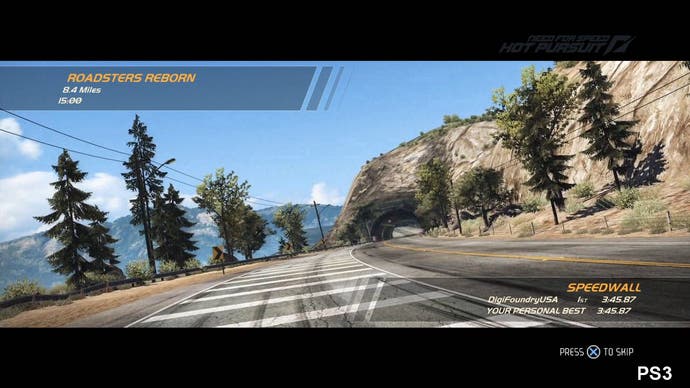
Framebuffer analysis suggests that Hot Pursuit is running at native 720p with 2x multi-sampling anti-aliasing on both platforms. However, Criterion has some seriously impressive tech going on with regards reducing aliasing over and above the advantages brought about by the MSAA.
Right at the beginning of the racer level in the demo, pay particular attention to the power lines and road markings. Check out that crash barrier that snakes into the distance. These are exactly the kind of world object that usually break down into a sub-pixel mess the further "into" the game world you look. Here, the visual consistency is maintained all the way into the distance.
A small detail you might think, but the NFS game world is all about long roads that stretch into the distance, so reducing artifacting on faraway elements of the environment is a small but important part of the game's visual make-up.
A straight shot-for-shot analysis taken at the exact same point in the two respective demos seems to suggest some difference in the lighting scheme. In actual fact, the lighting is completely identical: the differences are down to the cloud cover overhead, dynamically adjusting the lighting below. In scenes where the 360 lighting looks brighter, it's actually the game itself adjusting the exposure of the scene based in part on the same cloud-cover. Similarly, in the night-time scene, the difference in the windshield lighting isn't a difference between the platforms, again it's a difference in the light bathing the scene owing to what is going on overhead.
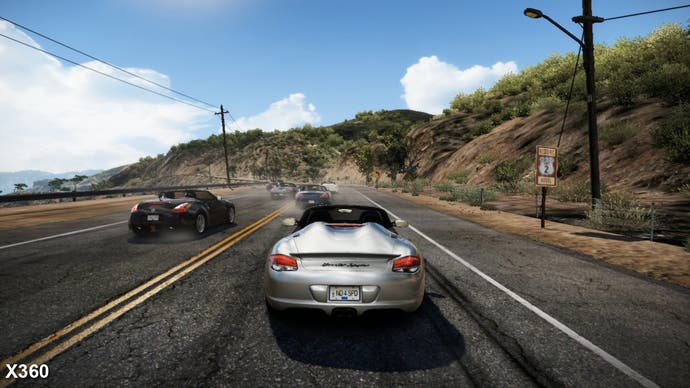
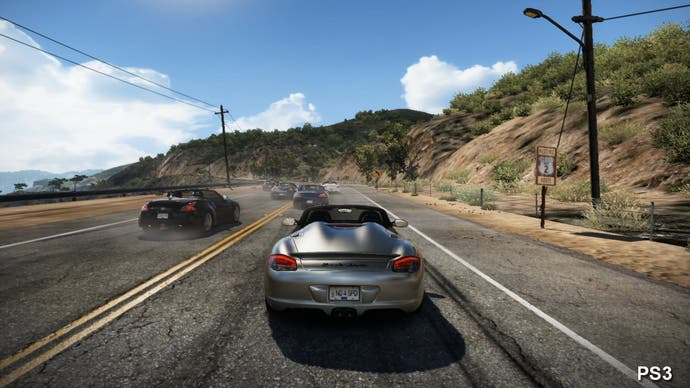
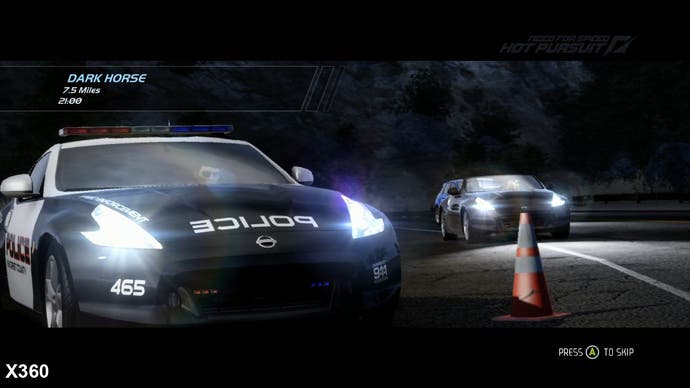

Performance-wise, the demo once again hints at an entirely like-for-like experience on console. The only time we see any kind of noticeable difference is in the intro movie on the racer stage, which seems to randomly stutter on both consoles, but this is an FMV issue, not an engine problem.
There are two tracks in the demo, and the initially locked racer track is probably the best place to get a like-for-like style of measurement. In this pure racing mode, we can stick to the main road, avoiding the shortcuts to get as close to a like-for-like race as possible. What we see is that during gameplay, Hot Pursuit is locked at 30FPS on both platforms with no tearing whatsoever. Only in the non-interactive intro scene do we get to see any kind of variance from that, and even then it is effectively the same performance level on both consoles.
Onto the cop stage, and here we find that a like-for-like comparison really isn't possible. Since this is an all-out battle, the feeds from both consoles quickly de-sync, even though our time in the game is roughly the same. However, once again we see that regardless of circumstances Need for Speed remains locked at the 30FPS level at all times during gameplay, allowed to drop only when the camera shifts into Takedown mode.
Criterion allows the frame-rate to lower in these scenes in order to spend time on more impressive effects: the same principle applied in Burnout Paradise, where crash scenes ran at 30FPS - as they were slowed down, running at a very different tempo to gameplay, few people really noticed, especially as they were non-interactive.
Moving on from Digital Foundry-related matters for a moment, there have been some comments about the handling model in the demo being something of a departure from the control system in Paradise, with some people describing it as heavier and less responsive. On the latter point, it's true that in the drop from 60FPS down to 30FPS input latency will be increased - this is something we'll measure at a later date.
However, what should be pointed out is that the demo is only allowing you access to what are effectively the slowest cars available in the whole game. In the full game, directly after the roadster level you play in the demo, you gain preview access to an ultra-limited edition version of the Pagani Zonda which gives some idea of just how fine the handling model is on the higher-end cars.
Need for Speed: Hot Pursuit is a winner from both a gameplay and technical perspective, so expect something special from Digital Foundry closer to the game's release, and watch out for Eurogamer's full review then too.


